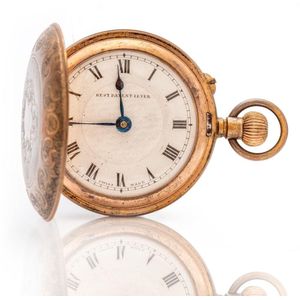Metal Hunter Best Patent Lever Pocket Watch Circa 1910
A metal hunter Best Patent Lever pocket watch circa 1910 4.4 cm dial diameter, 5.4 cm case diameter, 6.7 cm high. A metal hunter Best Patent Lever pocket watch. Circa 1910. Copper coloured metal hunter watch. The front of the case is decorated with a foliate border, in the centre of which is a shield with its own foliate border. The back with the same foliate. decoration, the centre with an urn full of flowers. The inside of both the front and back covers. bear the words "Warranted manufactured of the finest material 5 years". Evidently, that. warranty expired a long time ago. The back of the inside cover bears spurious marks and. designs and the words "Remontoir Perfectionne". Chased whitish metal dial, black Roman hour numerals. Marked "Best Patent Lever" and. "Swiss Made". Blued steel hands. Stem wind, lever escapement. movement not marked but, unlike what it says on the dial, does not appear to be Swiss Made. Hands set by pressing knob on side of case near winding. stem. Dimensions: 4.4 cm dial diameter, 5.4 cm case diameter, 6.7 cm high
You must be a subscriber, and be logged in to view price and dealer details.
Subscribe Now to view actual auction price for this item
When you subscribe, you have the option of setting the currency in which to display prices to $Au, $US, $NZ or Stg.
This item has been sold, and the description, image and price are for reference purposes only.
- Foliate - Decorated with leaves or leaf-like forms.
- Hunter - A hunter pocket watch is the type where the case includes a spring-hinged circular metal lid or cover, that closes over the glass face of the watch, protecting it from dust, scratches and other damage or debris. The majority of antique and vintage hunter-case watches have the lid-hinges at the 9 o?clock position, suiting the right handed user.
- Circa - A Latin term meaning 'about', often used in the antique trade to give an approximate date for the piece, usually considered to be five years on either side of the circa year. Thus, circa 1900 means the piece was made about 1900, probably between 1895 and 1905. The expression is sometimes abbreviated to c.1900.
- Lever Escapement - A lever escapement is a type of escapement mechanism used in mechanical clocks and watches to regulate the timekeeping of the movement. It was invented by British clockmaker Thomas Mudge in the 18th century and is now widely used in modern mechanical timepieces.
The lever escapement consists of three main parts: the escape wheel, the pallet fork, and the lever. The escape wheel is a wheel with teeth that is driven by the clock or watch's main spring or weight. The pallet fork is a two-pronged component that is positioned so that it can engage with the teeth of the escape wheel, and the lever is a small, L-shaped component that is attached to the pallet fork.
When the escape wheel turns, one of its teeth pushes against one of the pallet fork's prongs, causing the fork to pivot. As the pallet fork pivots, it releases the tooth and engages with the next tooth on the opposite side of the escape wheel. At the same time, the lever, which is connected to the pallet fork, rocks back and forth, allowing the escape wheel to turn at a regulated rate.
The lever escapement is prized for its accuracy and reliability and is commonly used in high-end mechanical watches. It allows for precise timekeeping by ensuring that the movement of the watch or clock is regulated and consistent, and its compact size makes it an ideal choice for use in small, portable timepieces. - Movement - The technical name for the workings of a clock or watch, and does not include the dial or case.
This item has been included into following indexes:
- pocket watches, case type
- pocket watches, country - Swiss made 463
